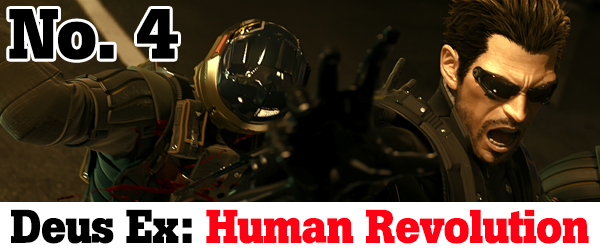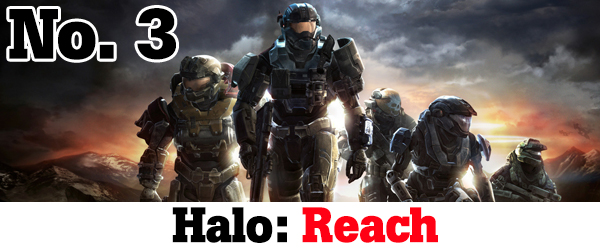Percentage of the vote: 8
Release date: 2011
Place in the series’ timeline: Human Revolution is set in 2027, 25 years before the first Deus Ex.
Staff Writer Evan Killham: In 2002, after I fell off of a ladder to my death in the first Deus Ex and lost two hours’ worth of progress, I declared it to be bullshit and never picked it up again. When Human Revolution came out in August, it was my choice for Game of the Year.
Developer Eidos Montreal’s prequel keeps everything I loved about Ion Storm’s original (before my untimely tumble from that ladder, that is): level variety, a skill tree that allows you to calibrate your character to your own playstyle, and in-game choices that feel like they actually mean something. What’s more, Human Revolution builds upon these concepts and refines them to near perfection. If you’d asked me a year ago to make a list of mechanics I would like obliterated from gaming, first-person stealth would have been at the top. Human Revolution makes point-of-view sneaking work so well that I couldn’t imagine playing it in third person.
And while we’re talking about stealth: In this game, stealth is just one option. It’s not always the “best” option. How many games encourage you to play how you want and then punish you with a quick and painful death for going on the offensive? Not this one. Every situation has multiple approaches, and all of them are valid. Unless you’re in a boss fight…you have to go lethal in those.
The most fascinating aspect of Human Revolution isn’t related to gameplay; it’s the fully formed moral quandary surrounding human augmentation. While Deus Ex’s nano-infused protagonist J.C. Denton is certainly unique in gaming, society is used to the idea and takes it more or less in stride. But Human Revolution takes place 25 years earlier during a time in which society is still trying to figure out the ethics and greater meaning of slapping robot parts on people. Some people call it progress, some people are terrified, and players willing to dive into the game’s wealth of in-universe literature will see all sides of the argument. The story’s final moral choice brings it all together by forcing players to decide where they stand. It’s clever, subversive, and it puts the first game — which takes place in a world that has already made up its mind — in a new perspective.
Neat prequel fact: Digging through some computer files at the Detroit Police Department reveals e-mail ordering a cover-up of an incident that takes place at the beginning of the game. These e-mail come from Joseph Manderely, who is J.C. Denton’s duplicitous boss in the first Deus Ex.
Percentage of the vote: 10
Release date: 2010
Place in the series’ timeline: Halo: Reach takes place in the year 2552, right before the events in the first game in the series, Halo: Combat Evolved.
Editor-in-Chief Dan “Shoe” Hsu: Gamers have gotten a few years of series protagonist Master Chief camping under the Halo spotlight, but Reach finally gave everyone an excuse to don a new set of Spartan armor. Just in time, too, as players were probably getting a little weary of all the (alien) religious overtones sneaking their way into this first-person-shooter franchise. Even though Reach introduced a big new gameplay element (armor abilities that give you special powers), it really brought the action back to basics with a refocus on military themes (vs. lone-wolf superman action), clear-cut enemies, and a plot that more or less made sense (no more talking weeds!). Forget saving the galaxy. Reach’s reach never really extended beyond one planet (um, the planet Reach…sorry). This adventure was straightforward and simple — and we liked it.
Neat prequel fact: In a normal world, a game developer would craft an overarching story and then fit individual sequences and chapters into that tale. Bungie apparently didn’t operate in a normal world when it created Halo: Reach. “From a construction standpoint, we scrapped telling a story first and packing a campaign into it,” said Marcus Lehto, creative director for the game. “We wanted to develop a key set of campaign moments that we believe would be more interesting and superfun to play and give this really great progression of events that player can be witness to.
“We started off with at least a couple hundred old ideas we wanted to tackle in the older games and new ideas that we mixed and matched around to build what we thought was the quintessential campaign. Soon, the story started having a life of its own, and the ideas started solidifying. It paid off with Reach because we have this great idea and great moments that truly tie in with each other.”



